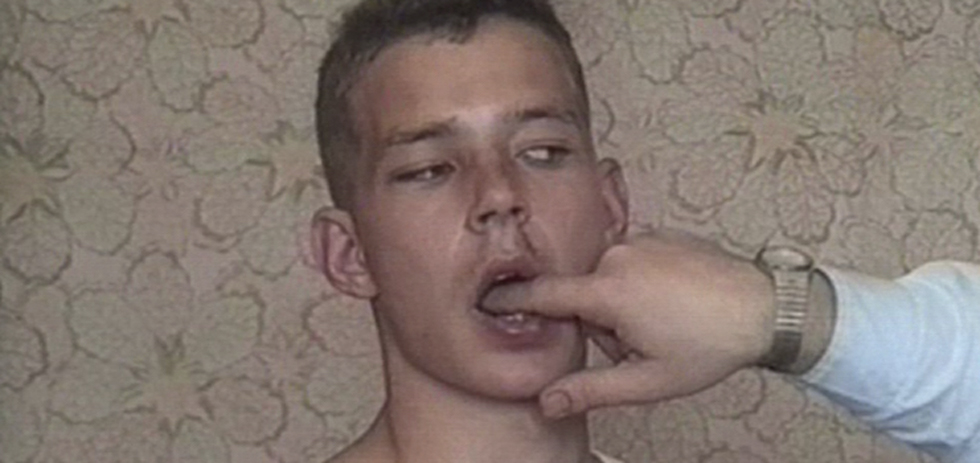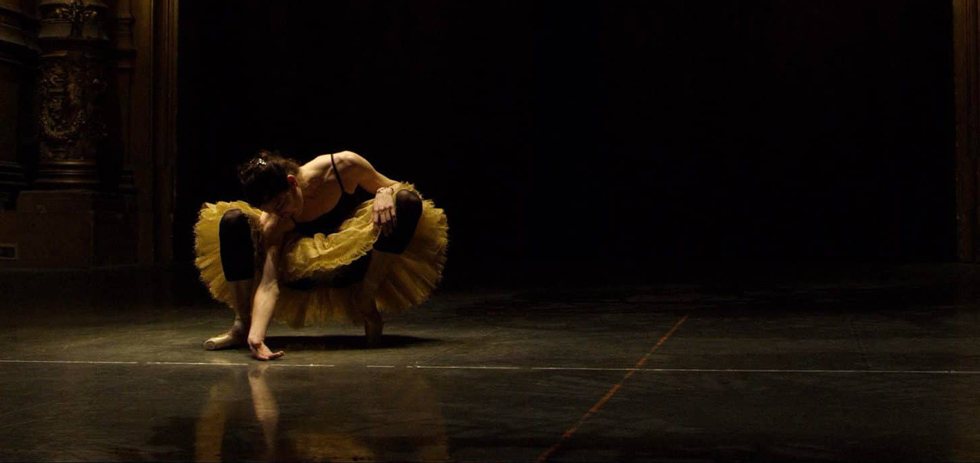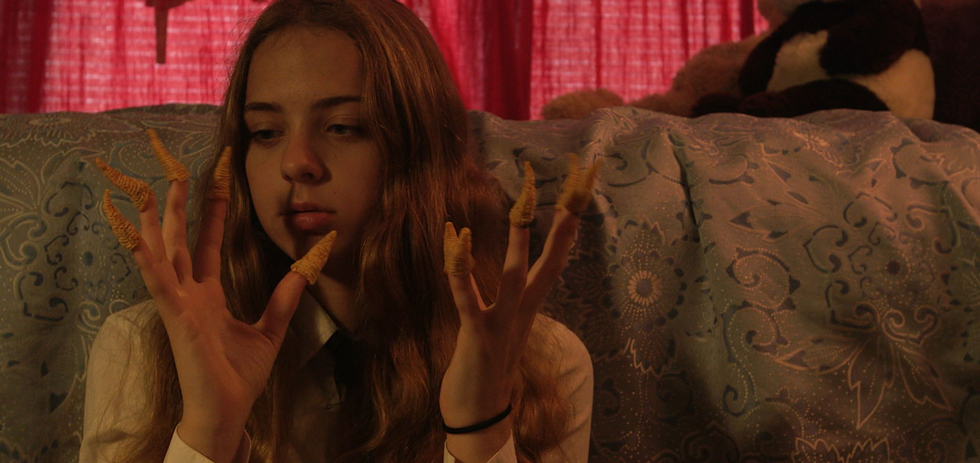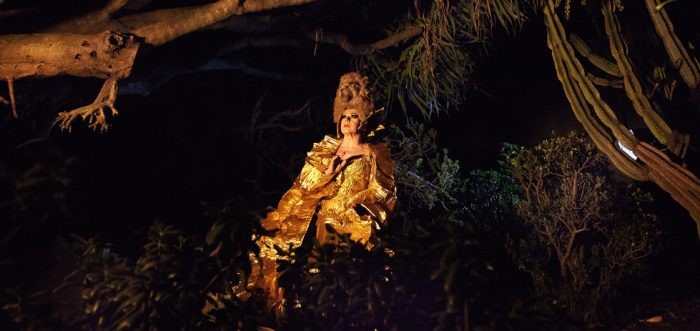Once again, Queensland Film Festival stands out from the local film festival landscape through its short film programming, which is concise and well considered.
In this feature piece, Jessica Ellicott, Conor Bateman and Luke Goodsell write on some of the notable short films that screened this year.
Jessica Ellicott: QLDFF is admirable for its “no filler” programming style; the relatively small program means you know each of the films chosen are there for a very good reason. This is particularly evident in the organic short-feature pairings, like the Portugese double of João Pedro Rodrigues’ feature The Ornithologist and French director Marie Losier’s L’Oiseau de la Nuit (pictured above). João Pedro stars in the short, and also introduced Losier to its subject, the Lisbon nightlife legend Fernando, aka Deborah Krystal, who’s been performing at the club Finalmente for over thirty years.1 L’Oiseau de la Nuit is a short lyrical portrait of Fernando, layering the documentary aspect of its real-life subject with generous doses of fantasy. Each frame is coated in a feverish parade of sequins, feathers and flesh, giving literal form to the figurative creatures of the Lisbon night — mermaids, birds and lions take shape before the lens. L’Oiseau de la Nuit is the latest in a series of films focused on underground nightlife figures by Losier – her 2011 feature-length documentary on New York couple and performance art duo, Genesis P-Orridge and Lady Jaye, The Ballad of Genesis and Lady Jaye, is one I’m now very keen to seek out.
Natpwe: the Feast of the Spirits takes a similarly transcendental approach to the documentary short. Co-directed by French duo Jean Dubrel and Tiane Doan na Champassak, the film takes the Burmese tradition of the nat pwè festival as its subject, where tens of thousands of people flock together around the full moon in August to pay tribute to nats (spirits). The ritual involves a trance-like invocation of the nats by mediums (nat kadaws), typically represented by members the gay and transgender community. The filmmakers adopt a cinéma vérité style, eschewing narration or exposition and directly immersing the viewer in the chaos of the proceedings. Shot mostly in close-ups, the presence of the camera, and by extension the filmmaker is implied – while the subjects mostly seem too involved to take notice, eye contact is made. Natpwe offers a vivid snapshot of an astonishing event, but this privileged proximity does raise questions about how welcome a presence the camera was.

Conor Bateman: One of the biggest surprises in this year’s Queensland Film Festival program was the selection of William E. Jones’ 1998 documentary short The Fall of Communism as Seen in Gay Pornography. Rather than playing as part of a retrospective sidebar, The Fall of Communism was paired with Eduardo Williams’ sprawling celluloid journey The Human Surge. The link between the two films might seem oblique at first, but QLDFF co-director John Edmond sees both works as dealing with “connectivity, exploitation of youth and the sexual portraiture of masculinity”.
Mining pornographic film for its social context is a feature shared by a fair amount of Jones’ film work.2 The Fall of Communism was the first of his short films to have repurposed gay pornography as its subject, predating a series of films made in 2006 — All Male Mash Up, V.O., Film Montages (For Peter Roehr) and More British Sounds. The 1998 film is the only among them, though, that contains Jones in voiceover, perhaps a carryover from his 1997 feature Finished, which chronicles the life and death of porn star Alan Lambert through repurposed pornographic footage, voiceover narration and static landscape images.
Though the short’s matter-of-fact title suggests a rigorous analysis of late Soviet-era pornography, a close study of iconography is contained to the first four minutes. The rest of the film is impressively (and at times amusingly) cut, relying more on nimbly arranged montage than didactic voiceover. The insidious influence of Western capitalism, mentioned specifically by Jones halfway through, only gets its true visual counterpart in one of the final shots; as the grubby off-screen director fingers the mouth of a young performer, his dress shirt cuffs and Rolex slip into frame. The use of English subtitles, an act of translation and repackaging for a Western audience, brings with it a unique sense of complicity; these young men, selling their bodies for Western consumption, are now fodder for Western study.
Gaspard Kuetnz’s UZU, fittingly paired with the spectacle-centric Brimstone & Glory, comes to shocking, searing life in a four-minute stretch, a little over midway through the film’s 28 minutes. GoPros are strapped to two wooden shrines — Mikoshis — held up by tens of generation-spanning men standing opposite each other in a packed town square. Despite the regimented lines, some of the footsoldiers occasionally break ranks, spitting venom at their opposites. The specific four-minute stretch I’m thinking of is the moment when the actual Mikoshi fight begins, and the wooden shrines smash into one another. The cameras fall, or rather the Mikoshis turn over, and all we see is black, with pockets of light jutting in around the same time we hear the pained screams of the men trapped beneath it, and us. The violent chaos is arresting because it’s still perversely ordered. Everyone willingly submits to the traditional barbarism, and as the fight continues we adopt the perspectives of onlookers, some at street level, contending with punch-drunk fighters and others high above, peering down with a tempered curiosity from their balconies.
The vignettes that sandwich this violent conflict, quiet reflections on masculinity in Japan, make for frustratingly conventional viewing. There’s little in the way of actual understanding or feeling; we spend so little time with the handful of men selected that they slip so easily in caricature: one is heavily tattooed, another gambles, an old man offers a prayer to the sun. My knowledge of the Dogo Autumn Festival in Matsuyama is about the same at film’s end as it was after I read the festival blurb hours earlier. Tradition and understanding fall to the wayside, though the bracing spectacle makes a distinct impression.

Preceding Neïl Beloufa’s theatrical set-set Occidental was Bertrand Bonello’s 2016 short Sarah Winchester, Ghost Opera, which presents a kind of deconstructed opera rehearsal. Ballet dancer and choreographer Marie-Agnès Gillot is the corporeal presence of Sarah, the heir to the Winchester rifle fortune who was driven to madness following the death of her infant daughter; the personal tragedy is divorced from the collective one — baby Annie passed away within a year of the Civil War ending, a conflict in which her family’s rifles played a significant part.
Gillot’s movements around the vacant stage of Paris’ Opéra Bastille are scored by electronic pulses, triggered by the director/composer (Reda Kateb filling in for director/composer Bonello), who stands at his MacBook among the empty seats. Gillot also moves to the sounds of a choir, who sing out an ode to Sarah’s misery, in a few sequences removed from the dark, claustrophobic space of the Opéra Bastille.
Early on there is a pan up to the first balcony, less so an act of architectural admiration (though we see much of Carlos Ott’s sleek, clean design throughout) than a growing sense of containment. The stage area is simultaneously fixed in space — we see Gillot speak with Kateb in a wider shot — and out of reach; a young girl, blood from a head wound staining her white gown, wanders through the cavernous building, drawn to the stage but taking a disjointed path. The intertitles, which act as program notes, also have a slippery relationship with direction. A neat san serif font serves as the container for the abridged life story of Sarah, broken up into an operatic three acts, but they go beyond description. This information instructs the performers. Kateb often elaborates on the stories immediately after in voiceover, not for Gillot but the film’s viewers, who are kept at an entrancing distance.
The opera they rehearse is one that will never be performed; Kateb announces mid-film that the opera does not exist. This reorients our relationship to its artistic components: they are each their own whole, whose loose connection to the Winchester history is a provocation — the story of mechanical engineering, repetition, loss and isolation finds merely an echo in the dance, the song, the building, the image. Before the final display of Gillot’s precise, constricted movements, Kateb directs her: “Do the solo in your head.” The substance of history is absent by design, so we must build upon the conjecture.

Luke Goodsell: The short films of American director Jennifer Reeder occupy an unusually specific space. Operating within an ostensibly teen genre, the pieces move fluidly between an immediate youthful presence and a reflective adult perspective, tapping into the psychic resonance of emotional states that seem to exist simultaneously across generations. 2014’s A Million Miles Away begins from the distinct view of several high school girls, depicted in various states of personal flux as they prepare for a choir rehearsal class. An early, unforgettable montage fuses their adolescent anxieties via one girl’s bedroom a cappella of Madonna’s “Like a Prayer,” locating the track’s spiritual turmoil and transposing it to the rituals of preparation enacted by teenagers in their private moments. That the song — and their subsequent choral performance — evokes the 1980s is no pop culture throwaway: the film unexpectedly pivots on the existential meltdown of the girls’ substitute music teacher, a middle-aged woman (Jennifer Estlin) tethered to her teenage iconography. Reeder’s empathy for details that might otherwise be laughed off as kitsch — she finds the sublime in the electric eyes of the teacher’s gaudy cat-print sweater — builds toward a devastating finale, as the students unite in a temporally blurred rendition of Judas Priest’s “You’ve Got Another Thing Coming” that gives the Langley Schools Music Project a run for its spine-tingling money.
Reeder’s knack for distilling the beauty of pop returns in 2015’s Blood Below the Skin, which signals its sisterly affection early on with a teenage girl’s performance of Joan Jett’s “Crimson and Clover” — a cover of Tommy James and the Shondell’s ’60s hit that the rocker performed sans gender inversion, effectively announcing her own sexual orientation to the world. Much like the covert intimacy of Jett’s performance, Reeder’s film tracks the secret connection between three teenage girls, played out largely in the transformative confines of their bedroom sanctuaries. Echoing A Million Miles Away, Blood operates in an uncanny emotional register, approaching its subjects with both an acute understanding of the teenage experience and the capacity to observe the scenario with an adult eye that neither condescends or leans on the easy shorthand of cultural iconography so typical of the genre. This is my first encounter with Reeder’s work, and I fell hard for both of these films within moments of their opening frames. Needless to say I’m looking forward to what the director — whose current feature Signature Move recently began its festival rounds — does next.
You can read our piece on the short films at last year’s Queensland Film Festival here.
